Feeling their roots, comfortable in their own skin, a nest for birds, there are no words for the beauty, splendour, the wonder of our trees.
Sorry to rather mangle a celebratory song from the 60s (about hair), to celebrate trees, specifically in our garden and by focussing on roots, lichen and bark.
In our garden, a number of indigenous trees were planted by prior owners on this half-acre of land as well on adjacent land on the edge of a commercial plantation. We have continued to plant indigenous trees (and unfortunately fell some), and many of the older trees are maturing beautifully with magnificent roots and impressively textured bark.
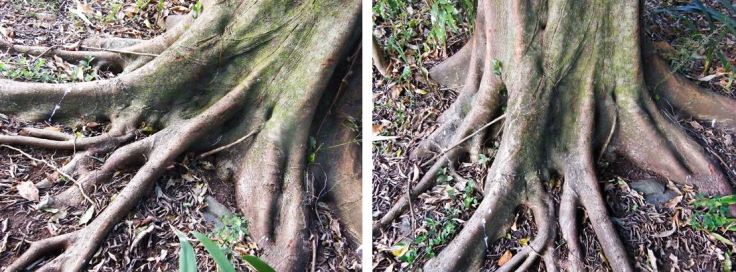
Pictured above are the roots of a relatively young Natal Fig (Ficus natalensis)
Often when we appreciate trees we think in terms of shape and foliage, but the bark too is aesthetically pleasing, and also when lichens attach themselves to trunk and branches. Interestingly, lichens are composite organisms, being symbiotic associations between fungi and green algae or cyanobacteria.
Lichens do not damage the host tree. The outer fungal coating collects moisture and minerals from the air. The green pigment in the algae/cyanobacteria enables the food-producing process of photosynthesis to take place, and the lichens are not feeding on the tree bark.
An additional bonus is that as lichens do not grow where the air is polluted, their presence can be seen as an indicator of good air quality.

These lichens are attached to a Crossberry (Grewia occidentalis). Lichens may be more prolific on older trees because the more textured bark makes it easier for them to gain a foothold. Contrary to popular belief, although lichens may be seen growing on trees that are in distress, the lichens are not the source of the tree’s problems, and lichens should be distinguished from fungi that are growing separately on their own. For more information see here There is no need to worry about the presence of lichens; rather, they can be enjoyed as another dimension in the tapestry of living organisms

These beautiful lichens are attached to the trunk of a Pigeon Wood (Trema orientalis). Lichens provide food for some animals, and many species of birds collect lichens as nesting material
As aptly described in one of their books on indigenous plants in South Africa, David and Sally Johnson note that the bark of a tree “provides much the same function as the hide of an animal, providing protection and insulation, and preventing loss of water” (p.18). The functioning of bark is interestingly complex, but I am limiting this post to highlighting the aesthetic qualities of bark.

The Fever Tree (Vachellia xanthophloea) is famous for its unique yellow bark. It has an interesting powdery texture with hints of green showing through the yellow
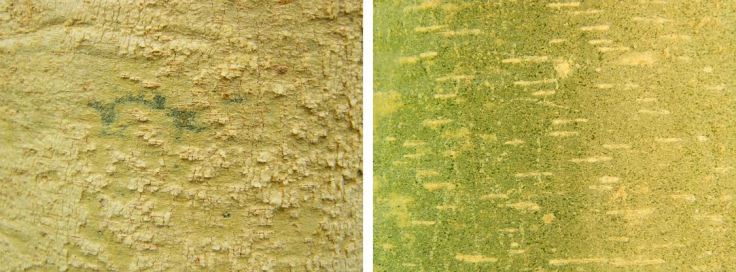
In addition to the lichens they may host, the bark of trees offers us much to enjoy in terms of colour and texture. Crevices and flaking bark provide homes for small creatures, which in turn become food for others, including insects, birds and reptiles.

Can you spot this cryptically coloured Tree Agama in its sleeping quarters? This Agama spent every night in this spot on a tall dead tree stump (of a Jacaranda tree) for a period of about two weeks before moving on. After we felled this (alien) tree, we decided to leave the tree stump standing to provide habitat for such creatures
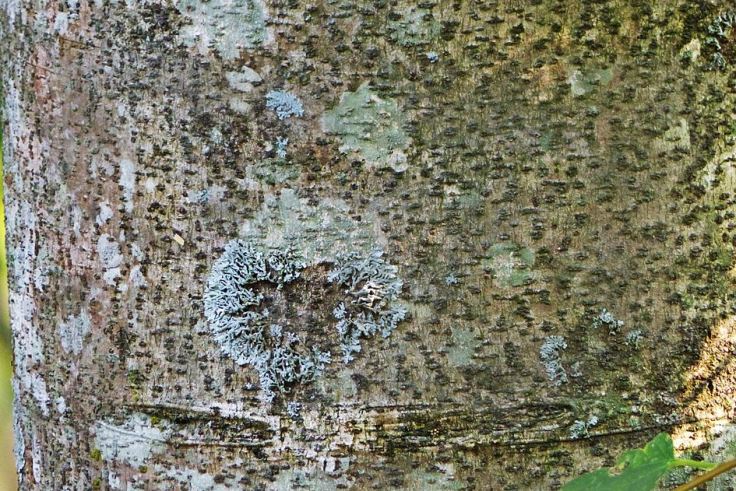
The textured bark and lichen on a Pigeon Wood tree (Trema orientalis)

A study in contrasts: The richly coloured and lichen-decorated bark of an Outeniqua Yellowwood (Podocarpus falcatus) tree – the wood is yellow not the bark – and the fissured texture of a Tree Fuschia (Halleria lucida) trunk
Perhaps the most interesting bark of any tree in our garden is that of the Copper-stem Corkwood or Red-stem Corkwood (Commiphora harveyi). The Afrikaans name for Commiphoras in general and particular, reflecting how easily they grow (poles cut from the tree and stuck in the ground for fences strike easily), is “kanniedood” meaning cannot die. Commiphora belong to the Myrrh family and there are 40 species that are indigenous to southern Africa.
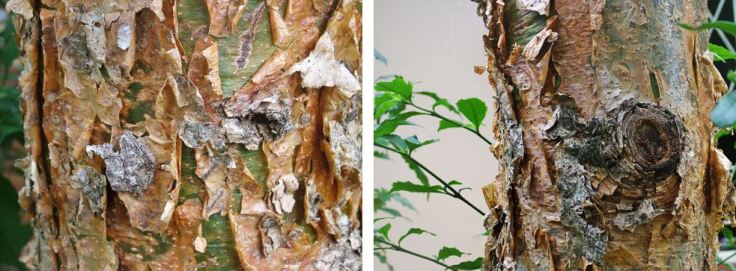
The bark of the Commiphora harveyi exfoliates in paper-thin sections revealing tones of green to bronze beneath.
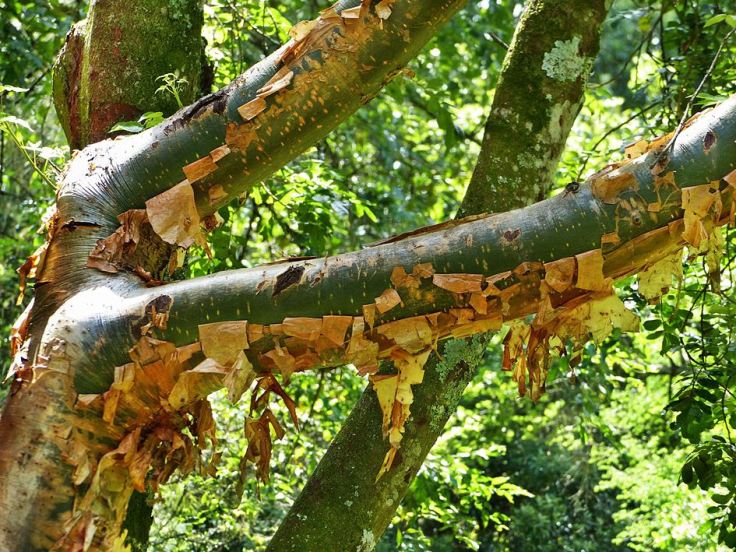
In the picture below, I like the contrast between the shiny smoothness beneath the flaking exterior of the Commiphora with the lushness of lichen on the stem of its unidentified neighbour in our garden
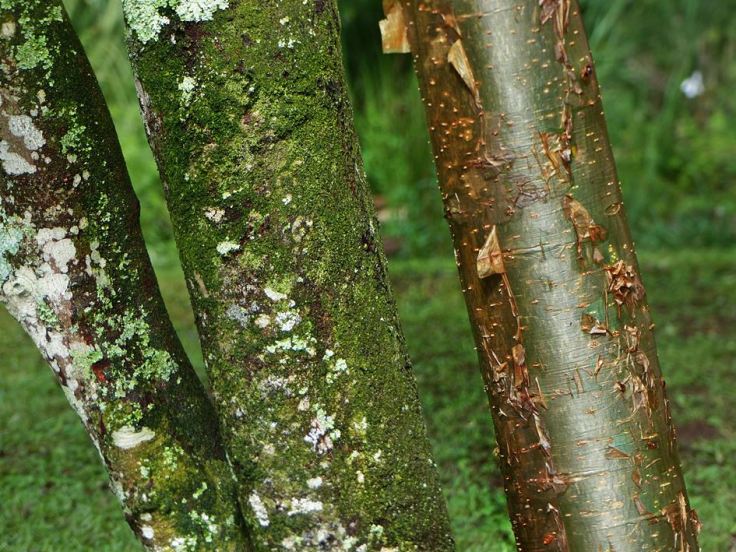
There are people, cultures, ancient traditions and religions that believe in the healing or sacred power of trees. It is generally accepted and acknowledged that spending time in natural environments and feeling connected to nature enhances a sense of well-being.
Who has not felt comforted, awed or inspired in the presences of trees – be it in a grove, an avenue, a forest, or in the shade or shelter of a favourite tree?
Perhaps being barking mad can be perfectly rational as trees can function as powerful presences helping us feel a sense of connection to the natural world and to our ancestors. And planting a tree can be an act of hope for the future.
Sources: Pooley, Elsa. 1997. The Complete Field Guide to Trees of Natal, Zululand and Transkei. Durban: Natal Flora Publications Trust; Johnson, David and Sally. 1993. Gardening with Indigenous Trees and Shrubs. Halfway House: Southern Book Publishers; Rutgers New Jersey Agricultural Experiment Station: Tree-Dwelling Lichens https://njaes.rutgers.edu/pubs/fs1205/
Posted by Carol

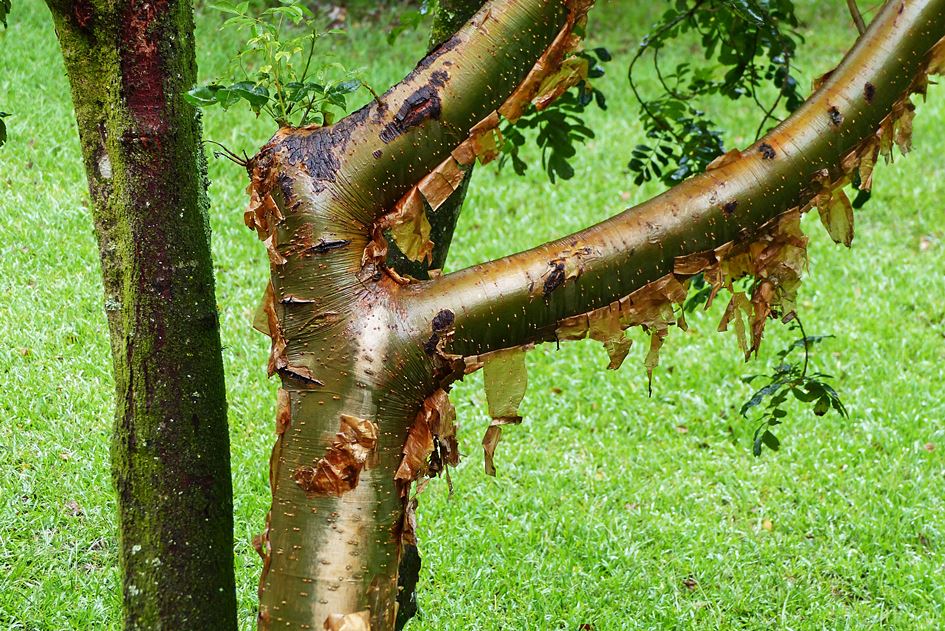





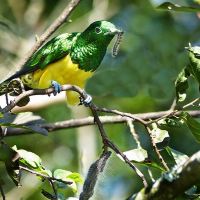
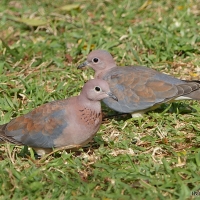
January 17, 2018 at 12:53 am
I love the information about Lichens and air quality that’s super interesting thank you!!
LikeLiked by 1 person
January 18, 2018 at 8:30 pm
Thank you. I was also interested to learn this about lichens 🙂
LikeLiked by 1 person
April 8, 2017 at 3:15 pm
Wonderful post. I too, love trees, and delight in the contrasting textures of bark. I especially love lichen but I knew next to nothing about it so your post has been very enlightening. My pleasure in lichen has deepened.
LikeLiked by 1 person
April 8, 2017 at 4:26 pm
Thanks Sandra. It was only when writing this post that I learnt that about lichen too!
LikeLiked by 1 person
April 7, 2017 at 11:02 am
Wonderful post. I love trees and moss and lichen. I recently read “the Hidden Life of Trees” by Peter Wohlleben. Your post follows after it nicely.
LikeLiked by 1 person
April 7, 2017 at 12:24 pm
Thank you so much Sherry, and glad that you love them too. I will look up the book you mention – it sounds interesting.
LikeLiked by 1 person
April 7, 2017 at 9:57 pm
Hope you do. I give it a 10/10
LikeLiked by 1 person
April 7, 2017 at 9:42 am
“He who plants a tree, plants a hope.”
– Lucy Larcom, Plant a Tree
I have always been drawn to the colour and texture of the bark of different trees – which is why a recent walk through the forest at Tsitsikamma was such a pleasure. You must be living in a tree paradise!
LikeLiked by 1 person
April 7, 2017 at 12:22 pm
Thanks Anne, and for the particularly fitting quotation. The Tsitsikamma trees are a treat – although we are extremely lucky here and we appreciate what we have, its not as good as a real wild forest!
LikeLike
April 7, 2017 at 6:53 am
Lovely Carol! I too adore the tree textures, lichen and bark.AND you helped me remember that a tree I saw a couple of weeks ago and simply could not remember it’s name, despite the very obvious, and diagnostic, peeling skin – Commiphora!
LikeLiked by 1 person
April 7, 2017 at 12:18 pm
Thanks Nikki. Its nice to share the features of trees that are often overshadowed (so to speak) by the bigger picture and to know that others love these aspects too. And glad to assist coincidentally with the name of the tree – so frustrating when one just can’t quite remember!
LikeLiked by 1 person
April 6, 2017 at 8:15 pm
I’m a bit of a bark junkie, so I loved this post.
LikeLiked by 2 people
April 7, 2017 at 6:21 am
Thanks Margaret. Yes, it can be addictive once you get into it.
LikeLiked by 1 person
April 6, 2017 at 8:02 pm
Such a wonderful variety of textures and colors.
LikeLiked by 1 person
April 7, 2017 at 6:19 am
Thanks Sandy. Yes the variety is almost endless. The more I look the more I see!
LikeLiked by 1 person